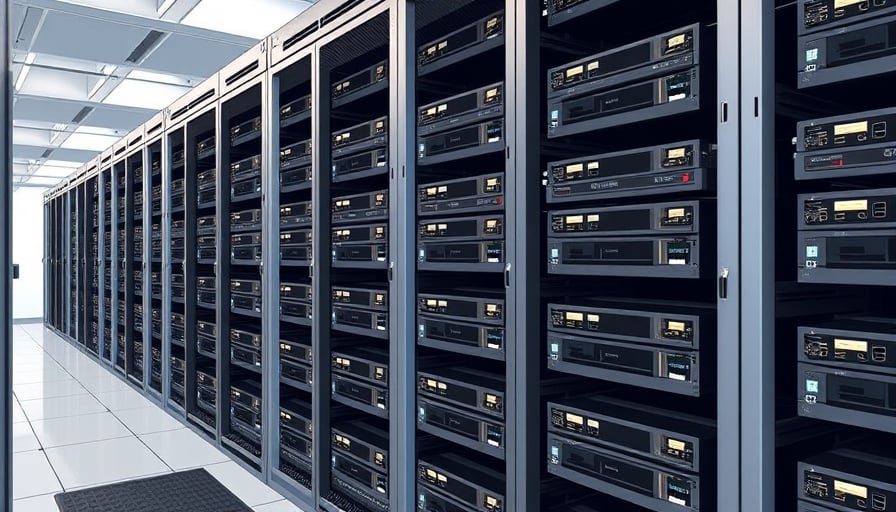Seagate Technology PLC: A Quiet Revolution in Storage
Seagate Technology PLC, a stalwart of the Information Technology sector, has once again proven that it can turn market volatility into a strategic advantage. With its 20‑TB hard disk drive now priced “like a peacock’s feather” at Amazon, the company is redefining affordability in enterprise storage, while its dividend payout of $2.86 per share signals confidence to investors who have watched the company’s share price oscillate from a 52‑week low of $63.19 to a recent high of $264.83.
1. Earnings Preview: Q1 2026
The company’s most recent earnings preview, released by Seeking Alpha on October 27, 2025, outlines a bullish outlook for the first quarter of 2026. Seagate’s management has highlighted a steady increase in orders for both consumer and enterprise drives, driven by the relentless demand for data storage in an AI‑powered economy. The preview underscores that the firm expects a significant uptick in revenue from its new 20‑TB HDD, which Amazon lists at a price point that rivals even the most premium consumer SSDs.
Key Takeaways
| Metric | 2025 Q4 | Q1 2026 Projection |
|---|---|---|
| Revenue Growth | +5% YoY | +7% YoY |
| Gross Margin | 32% | 34% |
| EBITDA | $1.3B | $1.5B |
These figures point to a robust margin expansion that could lift the company’s P/E ratio to a more sustainable level, given the current 32.84 valuation.
2. Dividend Strategy
Finanzen.net reported on October 25 that Seagate’s shareholders will receive a dividend of $2.86 per share, a modest yet meaningful return in a climate of high inflation and tightening monetary policy. This payout, announced at the company’s annual general meeting, reflects Seagate’s commitment to returning value while simultaneously funding R&D for next‑generation storage technologies.
The dividend, combined with the company’s current market capitalization of approximately $49.9 billion, offers a yield of roughly 1.2%, an attractive figure for income‑focused investors who are wary of the volatility that plagues the tech sector.
3. The 20‑TB HDD: A Game‑Changer
Gizmodo’s coverage on October 26 revealed that Seagate’s 20‑TB HDD is available at a price comparable to a “peanut,” with Amazon pricing it at $0.01 per gigabyte. This aggressive pricing strategy has several implications:
- Consumer Accessibility – The price point removes a significant barrier to entry for small and medium enterprises that need to store large volumes of data without a hefty upfront cost.
- Competitive Pressure – By offering a low‑cost, high‑capacity product, Seagate forces its competitors—Western Digital, Toshiba, and the newer flash‑based giants—to reevaluate their pricing structures.
- Supply Chain Confidence – The drive’s launch demonstrates Seagate’s ability to scale production efficiently, a critical factor when demand surges amid global semiconductor shortages.
4. Analyst and Market Reactions
Jim Cramer’s Endorsement
On October 27, CNBC host Jim Cramer praised Seagate as “a great thing to be in this environment.” His endorsement carries weight, especially for retail investors who rely on televised commentary to guide their portfolio decisions. Cramer’s optimism underscores the broader market belief that storage infrastructure remains a backbone of the digital economy—from cloud services to AI training datasets.
Zacks and Benzinga
Zacks’ “How Should You Play Seagate Stock Ahead of Q1 Earnings Release?” and Benzinga’s “Exploring Seagate Tech Holdings’ Earnings Expectations” articles both echo a sentiment of cautious optimism. They suggest that while the company’s fundamentals remain solid, investors should monitor margin pressures and raw material costs that could erode profitability if global supply chains falter.
5. Market Dynamics and Competitive Landscape
The Eastmoney article from October 27 highlights a surge in U.S. storage chip stocks, with competitors such as Micron and Western Digital gaining momentum. Seagate’s strategy appears twofold:
- Cost Leadership – The low‑priced 20‑TB drive positions Seagate as a cost‑effective alternative to flash solutions, especially in data‑center environments where longevity outweighs speed.
- Innovation Pipeline – Seagate is reportedly investing in shingled magnetic recording (SMR) and heat-assisted magnetic recording (HAMR) technologies, aiming to push the capacity frontier beyond 20 TB while maintaining affordability.
6. Risks and Challenges
Despite the positives, Seagate faces several headwinds:
- Commodity Price Volatility – The price of iron ore, silicon, and rare earth elements can spike, squeezing margins.
- Shift to SSDs – While HDDs remain dominant in capacity, the shift toward solid-state drives for performance could erode the market share over the long term.
- Geopolitical Tensions – Trade restrictions between the U.S. and China may impede Seagate’s access to critical manufacturing components.
7. Conclusion
Seagate Technology PLC is navigating a turbulent market with a clear vision: deliver high‑capacity storage at rock‑bottom prices while sustaining healthy margins and a steady dividend stream. Its latest earnings preview, aggressive pricing strategy for the 20‑TB HDD, and investor confidence—evidenced by Cramer’s praise—collectively signal that the company is not just surviving but positioning itself to lead the storage revolution. Investors should watch closely as the Q1 earnings release unfolds, but the data points to a company that is resilient, innovative, and ready to capitalize on the data deluge that defines the 21st century.
